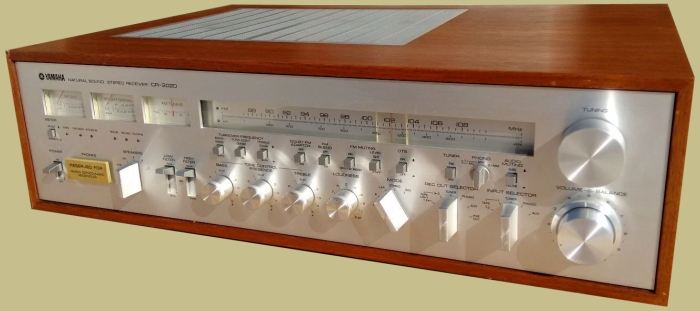
If you’re familiar with monster receivers then you know that the Yamaha CR-3020 is a Monster! Well, this receiver is just shy of a monster. Maybe Beast would be appropriate? It’s the Yamaha CR-2020 and is, of course, the smaller sibling of the CR-3020. Yes, the CR-3020 put out a massive 160 watts per channel but this CR-2020 shells out a very respectable 100 watts per channel. Besides, the CR-3020 didn’t even sell all that well.
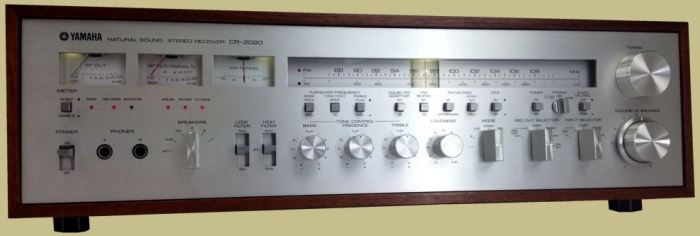
The CR-2020 is a fantastic mix of everything you want in a big, powerful receiver. Lots of power, tons of features, sharp, clean styling and a cool look when the room lights are dimmed. And, for that macho effect it weighs in at about 43 pounds and is over 21 inches wide and 16 inches deep. It was introduced in late 1977 and was priced very well since, at that time, the Japanese were able to build stereos cheaper than other US or European manufacturers.
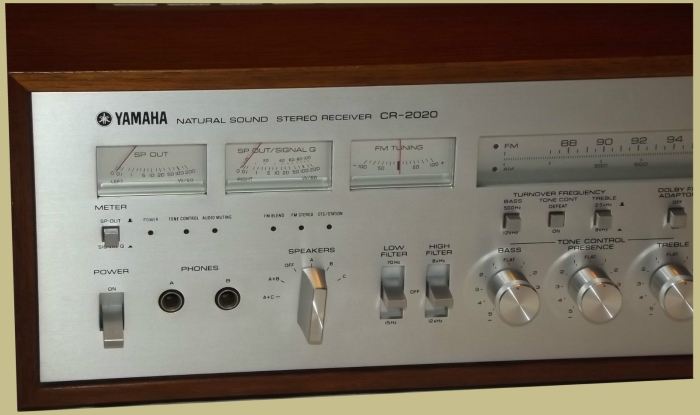
Yamaha receivers are known to be low distortion and their circuitry was designed to affect the signal as little as possible throughout the amplification path. The CR-2020 lives up to this ideal by having a maximum of 0.05% total harmonic distortion. In fact, Yamaha’s sales literature at the time coined the term Noise-Distortion Clearance Range (NDCR). Instead of measuring noise and distortion under lab conditions they setup the receiver in a typical listening situation and then measured the noise and distortion. They also called it Real Life Rated!

Some interesting features are:
- Continuous loudness compensation (variable loudness control)
- Two turntable inputs (one being mc)
- Independent audition and recording
- Connections for three sets of speakers
- Linear differential gain IF stage
- 4-gang tuning capacitor with dual-gate MOS-FETs
- Multi-function FM/AM/Signal/Multipath/Power meters
- MPX section included into NFB loop
- High-Blend switch (FM)
- Automatic or Manual OTS tuning system
- DOLBY adapter switch
- 2 Headphone jacks for Yamaha Orthodynamic and/or normal headphones
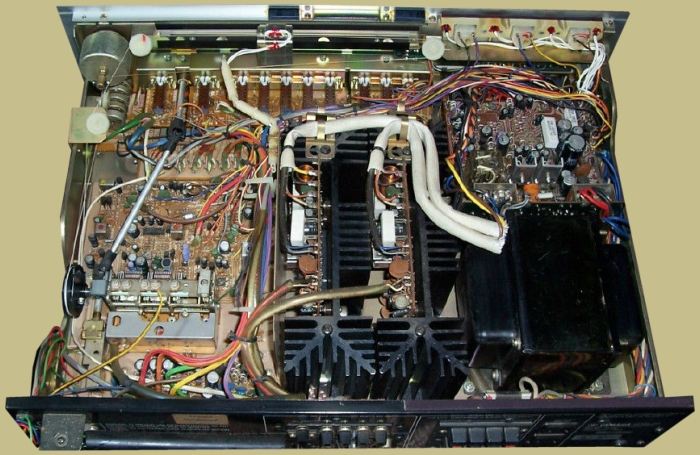
Check out the massive transformer at the bottom right. Those who aren’t Yamaha fans usually point to the bright sound of their receivers and overall lack of warmth. That may or may not be the case but Yamaha tried to make the output signal as true to the input signal as possible. I too find the Yamaha’s a little dry sounding but I have to wonder if my ear just prefers a little more distortion which is usually what gives a receiver that ‘warm’ sound.
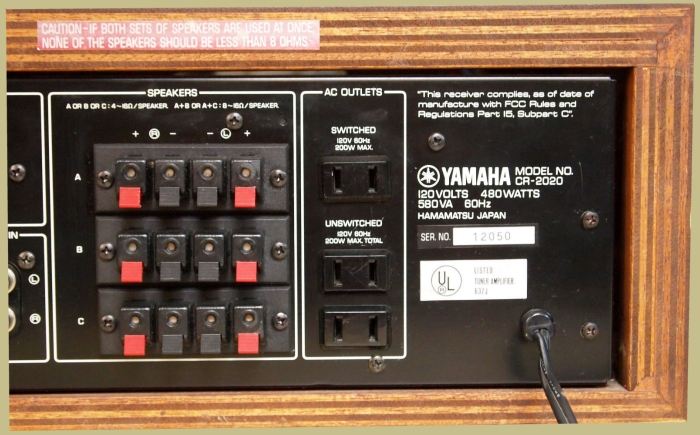
Two phono inputs and 3 pair of speakers connections. You can’t beat that. It even has a built in pre-amp section for moving coil cartridges. The Yamaha CR-2020 does have a weakness though. The power switch tends to fail and replacements are not that easy to find. So, if you’re contemplating buying one make sure the switch works and handle it gently when turning the power on and off.
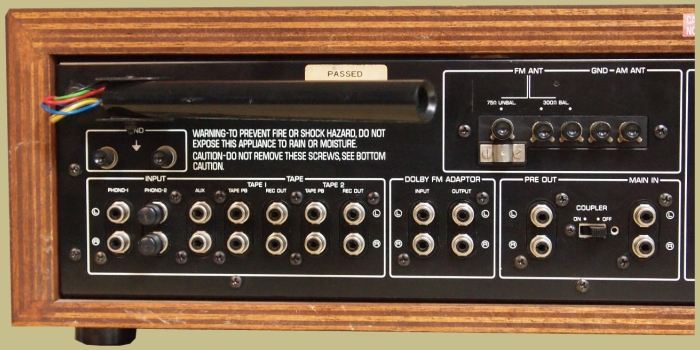
Yamaha receivers have a fairly large following so demand is pretty high. The monster CR-3020 is, many times, out of most peoples price range so the CR-2020 fits the bill more often.
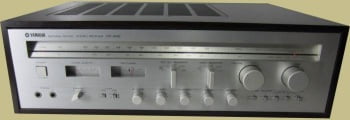

Many people discuss the brightness or lack of bass in Yamaha Natural Sound gear. AS an owner of a CR 2020, CR 620 and a AS 1000 I tend to agree however there is an easy fix.
Set all tone controls to flat and then turn down the treble a notch or two. Problem solved, all of the detail Yamaha is famous for but with the warmth everyone desires.
Which sounds better to you between the AS1000 and the CR2020.
Recently, my CR2020 has been kicking in and out losing the radio signal. Yesterday, it lost signal completely ???
Any thoughts on what the problem might be.
Thank you.
I had a 1020 for a short period of time. I have to totally agree with the very “Dry” sound. Very dissatisfying to listen to. Some people dig that yamaha sound and it may well be more technically ‘correct’. But for me, it was a no-go. The bottom of the pack compared to vintage Marantz or Pioneer units. I don’t think it has anything to do with distortion or anything magic that was done or not done. I think it’s simply the choice that the yamaha designers made in engineering the loudness and tone stacks. Sold mine fast.
Ahhh….Does Pioneer make grand pianos..??.does Marantz make guitars, or violins.??. That’s what I thought…You can knock Natural Sound all you want…that’s your choice, but why pick a Yamaha site.. go cry on your Marantz-Pioneer sound signiture site
It’s good to hear the cons are well as the pros! You act like a baby. Grow up!
I bought a new CR2020 in the 1970’s and still use it. The “Dry” sound is pure and virtually undistorted, distortion level is completely inaudable. If more bass or any other “enhancement” is desired that’s easily achieved through the tone controls as was mentioned in Richard’s post of August 11, 2016.
There is a problem with heat causing solder joints to fail causing intermittent of complete shutdown of the receiver but that’s easily fixed by getting the repair bulletin Yamaha issued for that and carrying out the modifications yourself or by someone else who is competent at soldering.
Greetings,
Would anyone happen to know if the
Yamaha CR-2020 is a ‘tube’ receiver or if it is ‘solid state’?
Also, does anyone have knowledge of any ‘tube fuses’ within this 43 pound beast of a machine.
Thank you in advance!
Cheers,
Johnny
It is solid state.
There are 4 tube fuses inside the CR-2020. One main fuse, 7 A. One on each of the 2 amplifier boards, 5 A. And one on the power supply/relay board, 5 A (if memory serves). Those fuses have saved my bacon more than once, I’m happy to say.
I had a CA2010. Intergrated receiver.
Paid $1000 in 1977. Great receiver!
I had a short in the circuit board. Couldn’t find anyone to repair for less than $200 or more. Sold it as is. I guarantee someone fixed it. My loss. Now looking for another one.
Alan
I also have a CR 20202 I bought new. I recently managed to get it repaired at a vintage audio shop which cost me $300, but it was worth it. The one I own does not have a scratch on it. My wife wanted me to send it to the Sally Ann until she foudn out what they worth.
I’ve been in love with my Yamaha CR2020 (connected to a pair of LaScalas) since 1979. As of late: it turns on, lights up, needles move, but NO sound comes out. I’v tried other wires and speakers. Nothing. There are no repair shops locally. Any suggestions? I hooked up the LaScalas to a Yamaha Rx V995. Good but not nearly the same clean, clear music that I’ve grown to appreciate.
action-electronics.net
He’s put my 2230 and other stuff back in service.
Greetings audiophiles,
I have a yamaha CR 2020 stereo receiver and pair of Fried Q3 stereo monitor speakers, as well as a NAD 7250 PE stereo receiver that could all use a loving home. Any interested parties willing to make a reasonable offer are welcomed.
I have an orig 2020 that needs some lites 2 different switches recapped and deep clean her. I’m not parting her out like I thought but but keep her to use as my own transplant cr2020 farm in case a older unrestored one bites the dust. What kinda shape is it in send me a couple picks, and might you want to trade for newer speakers or a small receiver. Just let me know so I can make you an offer today thanks
Sincerely
Bill Finnell
JC MO
Where can i get the AM BAR REPLACEMENT
Regarding the “dry” sound characteristic of the CR-XX20 series. I remember dealing with that issue when I “upgraded” from a Pioneer SX-980 to a Yamaha CR-1020. Back then (around 1978 or so), I was using the loudness contour on a regular basis. I actually got a chance to speak with the Yamaha representative (he just happened to be in the store) about this. He said most people do not understand how to use the variable loudness control. He told me the correct way to use it was to set the volume control to a normal “live” volume which should have no loudness compensation. Then use the loudness control to turn down the volume. The idea was that the correct loudness compensation curve is then applied for a relative volume. This allows the user to set the contour based on listening environment, source, and speakers/setup. That was the theory behind it anyway. This does make sense in the regard that some of the receivers and amps back then actually did “turn down” the loudness contour as the volume control was increased.
For Brian,
If you haven’t fixed it already,
I picked up a bargain CR-2020 with a “dead” right channel. The problem was the output transistors had failed and shorted, also blowing the two 5A fuses on the amp board. With the original Toshiba 2SD424 &524s long discontinued, ( The Ebay ones are Chinese fakes) Mouser to the rescue! ON Semi Mj21193 and 94s work perfectly, with a higher power dissipation to boot. My drivers and emitter resistors were fine, but ON semi has good replacements for those too. Check you speaker terminal connections to be sure there are no stray wire strands also.
Hope this helps!
Just got mine working, by tapping on the relay. Its been in storage for 15+ years. Coupled with my 70’s Genesis speakers, I truly forgot what audio is supposed to “feel” like. There was something lost in the 1980’s as manufacturers cheapened circuitry, reduced transformer sizes, and lighter, cooler-operating components. There is nothing like the purity and tangible organic sensation of higher quality sound reproduction.
I recently acquired a Yamaha CR2020 in a beautiful ebony hi gloss lacquere finish
It sounded good and after a while I decided to have a full recap down including Furutech IEC inlet , silver RCA chassis inputs AUX and Phono inputs and new upgraded speaker binding posts along with some other touches .
Result , Ohh my goodness .
Driving little Magnapan speakers with a Bluesound Vault 2 CD ripper and streamer I’m am shocked how good this little very inexpensive system performs even the headphone section is really good something I just tried with a pair of Fostex TH 900 headphones I borrowed to try.
We love the retro looks of the Yamaha and never expected performance like this .Dry sounding No , light low end , No , Feed it a good source and put some half decent cables into it and enjoy , Wow the Yamaha 2020 was one of the very best audio investments to date .
Main system , Magnapan 20.7 speakers , Rel Subs , Jeff Rowland amplifiers , Rockna Dac and Rockna Net .
Hi Merk, Would love to hear more about these mods. Were did you get them done? Thanks!
Hi Merk,
Same here. I am also trying to do a full restore, and would love to have more info!
Thanks.
Hey Merk, you have 20.7’s and you still need a sub driving the maggies with Rowland amps? Wow you must have one massive sound room there, Brian
Mark I just decided on the black lacquer for my 2020 but need a good place to have the electronics restored have any restored. I too am a Rel fan I need the upgraded 5 way binding post.
I currently have a Yamaha CR -1020 and although they can sound a tad dry compared to say a Marantz 2275(one of my all time favs) it still sounds beautiful in my opinion. I have it matched with some modified AR3a speakers and that has provent to be an excellent marriage. Very similar to the 2020 in looks, but has just the right amount of power for me.
fortunately im into electronics for the military…..thus most do not understand how to fully understand the sound control spectrum..i have one i restored had other receivers brand but this one the best i bought new..1975…still out performs others…super clean..!
I just took mine in as one side is cutting out. It’s the power on relay. 2nd time it has casued issues. The vintage audio guy told me it would sell for $1500 Canadian (about $1200 US) no problem. More than twice what I paid for it new. I am not parting with it. It does not have a scratch on it.
This line from the post sums it up: “The CR-2020 is a fantastic mix of everything you want in a big, powerful receiver. ” It’s got everything: great looks, a ton of useful features, great sound, and plenty of power. The adjustable loudness is a useful feature for dialing up the bass at lower volumes. Speaking of bass, it doesn’t have the bloated bass some vintage receivers have, which some listeners don’t like. What it does have is transparency: with good speakers, it reflects the quality of the sources that are going into it. You will hear details with this that you don’t hear in most other vintage receivers. I do turn the treble down one notch, because that transparency can sometimes result in a little brightness.
As others have noted, the CR-2020 needs an extensive service to sound its best. Once that has happened, it’s a fantastic piece of audio gear. One of the very best stereo receivers in its class (100 wpc range), and more affordable than comparable Marantz, Pioneer and Sansui.
Can you recommend reputable vintage repair shops? I live in the Florida panhandle and am willing to travel so that I may once again enjoy my Yamaha CR-2020.
Sorry, I don’t know anyone in Florida. My CR-2020 was beautifully restored by Stereo Rehab in Chicago. You could check on audio forums for a good tech in your area.
Hey Butch if you hear of a good service place let me know. I’m in Savannah GA. I will bet Tampa/ St. Petersburg/Clearwater area will though a bit far for me.
Not sure if anyone can confirm this;
I have the output of my DAC connected to the AUX input of the CR-2020. I notice that the signal is present on the REC OUT jacks of both the Tape 1 and Tape 2 outputs.
Does this mean the output signal is essentially split?
I know that with a dedicated switch selector, the input signal can only be present on one output at a time, thus I’m wondering if that would be a better solution to feed multiple headphone amps.
Thank you.
Anybody else notice the lack of the usual Giant Power Supply Filter Capacitors in the internal view of this receiver?
They are located under the pcb in front of the transformer. They are big!
I have done a full recap on my CR-2020.